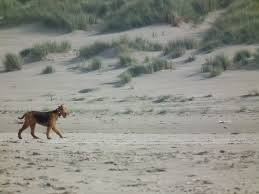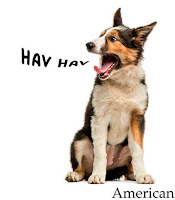I'm the biggest, the king of terriers, yes, I am.
We Airedales use hounds to sniff out and pursue the quarry, then we come in, go in a tight, dark underground den without the help of human handlers, and make the kill. Of course, bringing back the game to my beloved poacher.
Yes, I am the common mans choice of sporting dog. So, whaaaat, hey, I've also brought messages to soldiers behind enemy lines.
Oh, war-stories I can tell you, Jack ones was sent out, run half a mile right through enemy fire, broken jaw, one leg splintered, delivered message and dropped dead on the spot. Yeah, those were the days...
Okay, okay, even better, I FOUND wounded soldiers on the battlefield. Wolf and Prince started doing that already in 1916.
Oh, before I forget, I do police work, didn't know that didn't you, eh, eh.
So, vote for me, now!
I'm intelligent, have good scenting abilities and, and our wiry coats are easy to maintain. For sure, that's what the folk say about us...
Listen, humans say a lot of things and you might want to read some more about us truly amazing breed.
Okay, okay, don't twist my paw, one more fact. We served in the Red Army in the early 1920s. So, even russians are convinced of our qualities.
Okay, okay, just one more fact. We lost two of our friends on the.....Titanic.
Yes, yes, the last one, I promise. I, Lady Boy, was the first celebrity white house pet, who else. President Harding even had a special chair hand carved for me to sit on at very important Cabinet meetings. Impressed. Now, soldier, vote for your country, thus, vote for me, period.
Size
Dogs should measure approximately 23 inches (58 cm) in height at the shoulder; bitches, slightly less. Both sexes should be sturdy, well-muscled and well-boned.
Coat and Colour
Coat should be hard, dense and wiry, lying straight and close, covering the dog well over the body and legs. Some of the hardest are crinkling or just slightly waved. At the base of the hard, very stiff hair should be a shorter growth of softer hair termed the undercoat. The head and ears should be tan, the ears being of a darker shade than the rest. Dark markings on either side of the skull are permissible.
The legs up to the thighs and elbows and the underpart of the body and chest are also tan and the tan frequently runs into the shoulder. The sides and upper parts of the body should be black or dark grizzle. A red mixture is often found in the black and is not to be considered objectionable. A small white blaze on the chest is a characteristic of certain strains of the breed.
Head
Should be well balanced with little apparent difference between the length of skull and foreface. Skull should be long and flat, not too broad between the ears, and narrowing very slightly to the eyes. Scalp should be free from wrinkles, stop hardly visible, and cheeks level and free from fullness. Muzzle should be deep, powerful, strong, and muscular. Should be well filled up before the eyes. Nose should be black and not too small. Mouth: Lips should be tight. Teeth should be strong and white, free from discolouration or defect. Bite either level or vise-like. A slightly overlapping or scissors bite is permissible without preference. Eyes should be dark, small, not prominent, full of terrier expression, keenness and intelligence. Ears should be V-shaped with carriage rather to the side of the head, not pointing to the eyes, small, but not out of proportion to the size of the dog. The topline of the folded ear should be above the level of the skull.
Neck
Should be of moderate length and thickness, gradually widening towards the shoulder. Skin tight, not loose.
Forequarters
Shoulders long and sloping well into the back. Shoulder blades flat. Forelegs should be perfectly straight, with plenty of muscle and bone. Elbows should be perpendicular to the body, working free of sides.
Body
Back should be short, strong and level. From the front, chest deep but not broad. The depth of the chest should be approximately on a level with the elbows. Ribs well sprung. Loins muscular and of good width. There should be but little space between the last rib and the hip joint.
Hindquarters
Should be strong and muscular with no droop. Thighs should be long and powerful with muscular second thigh, stifles well bent, not turned either in or out, hocks well let down, parallel with each other when viewed from behind. Feet should be small, round, and compact with a good depth of pad, well cushioned; the toes moderately arched, not turned either in or out.
Tail
The root of the tail should be set well up on the back. It should be carried gaily and be of good strength and substance.
Gait
Movement or action is the crucial test of conformation. Movement should be free. As seen from the front the forelegs should swing perpendicular from the body free from the sides, the feet the same distance apart as the elbows. As seen from the rear the hind legs should be parallel with each other, neither too close nor too far apart, but so placed as to give a strong, well-balanced stance and movement. The toes should not be turned either in or out.
Faults
Yellow eyes, hound ears, white feet, soft coat, being much over or under the size limit, being undershot or overshot, having poor movement, are faults which should be severely penalized.
The use of any and all foreign agents for the improvement of dogs in the show ring, such as colouring, dilating the pupil, and stiffening the coat, is forbidden. Such acts are unsportsmanlike and unfair to those exhibitors who live up to the rules.
Scale of Points
Head......................................................................................... 10
 Neck, shoulders and chest....................................................... 10
Neck, shoulders and chest....................................................... 10Body.......................................................................................... 10
Hindquarters and tail............................................................... 10
Legs and feet............................................................................ 10
Coat.......................................................................................... 10
Colour......................................................................................... 5
Size........................................................................................... 10
Movement................................................................................. 10
General characteristics and expression.................................... 15
TOTAL 100
 Okay, okay, one more fact:
Okay, okay, one more fact:I LOVE OTTERS,
just love them to death...



































































